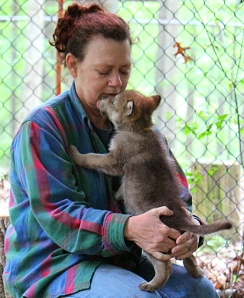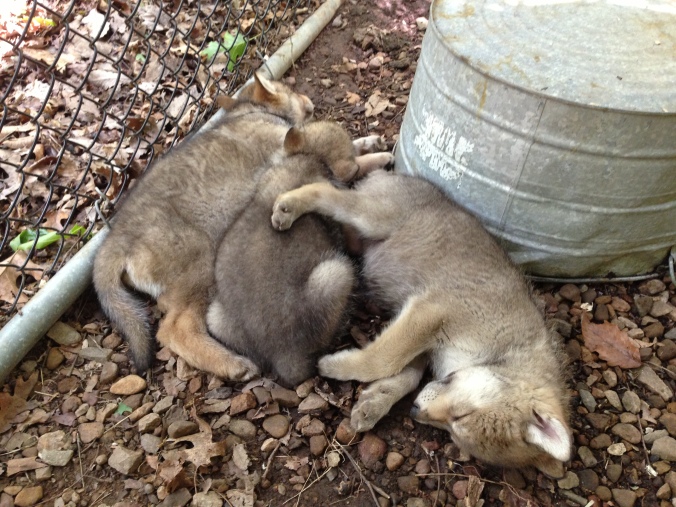Netar knew something was happening.
The sleek, dark-furred lady wolf trotted to the fence every time someone walked past, whining curiously and probably lamenting the two-legged wolves’ inability to properly communicate. Her sister Aiyana and brother Tanasi joined her, adding their inquisitive and excited whimpers to the conversation until the next warning clap of thunder sent them skittering to their warm, dry den.
I think they knew exactly what was about to happen. They remembered the covered section of Bays Mountain Park’s expansive wolf enclosure where they had lived as small, roly-poly puppies back in 2008 and where the two-legged wolves were currently gathering. They also recognized the camper and tents that served as their dens.
And they absolutely could not wait to meet the puppies that they knew were on the way.
Adult wolves adore puppies. It’s a simple fact of their lives and an instinct that has made this pack-oriented species so successful. In most wolf packs, only the alpha male and female have puppies, and the pack works together to raise, protect, and teach the little ones. The instinct to nurture puppies that they had not even met was no less potent in the captive wolves at Bays Mountain Park.
We two-legged wolves shared in the pack’s excitement as we huddled in the crowded camper while rain drummed on the forested canopy and thunder rolled overhead. Rhonda Goins, the naturalist spearheading the wolf program, called with regular updates as she and her precious cargo drew closer to the park. The Puppy Palace was ready, our cameras were poised, and we “Puppy Parents” stood waiting to meet the new arrivals with open arms.
The rain picked the perfect time to subside, leaving the mountain air cool and refreshing as the sun began to set and a giant white van lumbered down the gravel road to stop in front of the Puppy Palace.
Despite the palpable excitement in the air, the volunteers and naturalists kept the atmosphere as calm and laid-back as possible. These month-old puppies had just traveled non-stop for two days across state boundaries, through hailstorms, and arrived at a completely new, alien location with little in the way of comfort or familiarity. We certainly didn’t want to add to the stress with a bunch of overly excited human noises, so we waited, breaths held, as Rhonda and her team lifted the crate from the van and carried it with utmost care into the Puppy Palace.
You know how domestic puppies run when they’re really young? Their front feet fly out in front of their little bodies, as though they’re still learning how to coordinate all four limbs, and they bounce when they run? I think the term is “romping.” And part of you worries that they’re going to trip over their over-sized paws and face-plant at any second, so you watch them extra closely?
Oh, and you know how that entire mental visual is just too stinking cute?
Well, that’s exactly what happened as soon as Rhonda opened the door of the carrier. Four puppy-shaped balls of fluff came tumbling out all at once in a quiet chorus of happy whimpers and curious excitement. Unlike dogs, wolves don’t bark, so they didn’t make the typical “yapping” sound you normally hear with domestic puppies.
Mere minutes after their arrival, I could already see hints of the pups’ unique, budding personalities. Rust-colored Unalii, the oldest by a few days, explored and sniffed every nook and cranny of his new home with a quiet, fearless reserve. Ahuli and Ela, the blonde-furred brother and sister, shamelessly piled into the laps of the humans seated in the Puppy Palace and greeted their new two-legged pack with cuddles and puppy kisses. And little Takoda, black with a patch on white on her chest, ranged between greeting her humans, wrestling with her fellow pups, and exploring, as though trying to take in everything at once.
But the final, unifying touch of the night was hearing Netar, Aiyana, and Tanasi howl in response to the calls of their human pack. By howling, they reached out to their beloved human pack and greeted the pups that they were so eager to meet. As for the pups, they were too excited with their new surroundings to do much more than whimper in response.
That’s okay. It won’t be long before the mountain echoes with the song of seven adult wolves, and they’ll get in plenty of practice until that time comes.
Comment Questions: Are you surprised to learn that wolves don’t bark? Have you gotten to visit the puppies yet? What do you want to learn about in this blog related to the wolf puppies? Don’t forget, you can still leave a comment even if you don’t have a WordPress account!



Where did the puppies come from?
Maria, the puppies were born at a captive breeding facility in Minnesota called Wildlife Connection. They also book photoshoots so photographers can get up close with the animals. Google them if you’re interested! It’s a pretty cool place!
I would like my 2 year old grandson to meet the wolf puppies when we come to the park on Tuesday August 5th please.
Cell # 423 341 5313
Thank you Barbara
Hi Barbara,
You and your grandson are of course welcome to visit the park and see the puppies in their pen, but we can’t let non-staff people or children of any age into the pen with the pups. It simply wouldn’t be safe for your grandson. I know the pups look tame and cute, but they are full-blooded wolves and wild animals at heart. At this point, they’re too old to start bonding with new people, whether adults or children, and would see any newcomers as intruders.
We really look forward to your visit! If you want my advice, try and come with your grandson later in the afternoon. The pups like to sleep during the heat of the day, but they get more active as the afternoon cools down. Have a wonderful day!